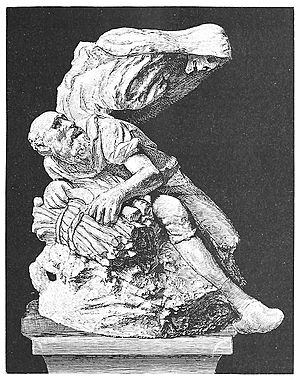The Old Man and Death facts for kids
The Old Man and Death is a famous story from Aesop's Fables. It's listed as number 60 in something called the Perry Index, which is a way to organize all of Aesop's stories. This fable is special because it's one of the few that features people instead of animals. Because of this, many artists, especially in France, painted scenes from it. A writer named Jean de la Fontaine made the story very popular there.
What the Story Teaches
This fable is a simple tale that shows how much people love life, even when things are really hard. It teaches us about "philozoia" (φιλοζωία), which means "love of life" in ancient Greek.
Here's how the story usually goes:
- An old man was walking a long way.
- He was carrying a very heavy load of sticks.
- He got so tired that he dropped his burden.
- He felt so miserable that he called out for Death to come and help him.
- Death appeared right away and asked the old man what he wanted.
- The old man quickly replied, "Please, good Sir, could you just help me lift my burden of sticks back onto my shoulders?"
Originally, in some older versions, the old man asked Death to carry the sticks for him. But the main idea is always the same: even when life is tough, people often still want to live.
How the Fable Became Popular
For a long time, this fable was mostly known only in ancient Greece. It didn't become widely known until the Renaissance, a period of great change and new ideas in Europe. During this time, the story started appearing in collections of fables written in Neo-Latin (a type of Latin used after the classical period) by poets like Gabriele Faerno and Hieronymus Osius.
A French version of the story also came out around this time in a book called Les Fables d'Esope Phrygien, mises en Ryme Francoise (Aesop's Fables from Phrygia, put into French Rhyme) in 1544. Later, in England, a Latin version was included in Francis Barlow's collection in 1687. This version even had a short poem about the story by Aphra Behn.
The fable's popularity really grew when it was included in La Fontaine's Fables. Jean de la Fontaine actually wrote two versions of the story and put them next to each other in his famous book:
- "Death and the Man in Misfortune" (La Mort et le malheureux, I.15) focused more on the lesson to be learned from the situation.
- "Death and the Woodman" (La Mort et le bûcheron, I.16) stayed closer to the original story. La Fontaine even wrote a note saying he wrote this second version because some people thought his first one was too different from the original.
See also
 In Spanish: El viejo y la muerte para niños
In Spanish: El viejo y la muerte para niños


